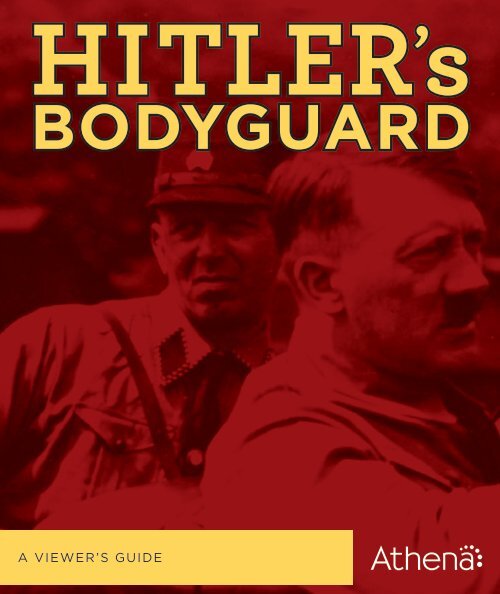Bodyguard - Athena
Bodyguard - Athena
Bodyguard - Athena
You also want an ePaper? Increase the reach of your titles
YUMPU automatically turns print PDFs into web optimized ePapers that Google loves.
Hitler ’s<br />
<strong>Bodyguard</strong><br />
a viewer’s guide
EpisodE 1<br />
How HitlEr’s <strong>Bodyguard</strong><br />
workEd<br />
Highlights<br />
• From the early days, Hitler’s personal security involved concentric<br />
circles: an eight-man SS Begleitkommando (Escort Command)<br />
at the core, a regiment of elite SS troops (the Leibstandarte, or<br />
“bodyguard,” SS Adolf Hitler) to protect his residences and offices,<br />
and the Führerschutzkommando (Führer Protection Command),<br />
which evolved into the Reichssicherheitsdienst (Reich Security<br />
Service, or RSD), responsible for overall security and advance work.<br />
• Besides encouraging rivalries among his various security services,<br />
Hitler relied on irregular habits and unexpected schedule changes to<br />
foil assassination attempts.<br />
Question to Consider<br />
The constant jockeying for favor among rival units might have<br />
encouraged absolute loyalty to Hitler. But what risks did this<br />
management style entail?<br />
1
EpisodE 2<br />
EpisodE 3<br />
Early attEmpts on HitlEr’s lifE kill tHE nEw CHanCEllor!<br />
Highlights<br />
• Both the black-clad SS led by Heinrich Himmler and the brownshirted<br />
SA (Sturmabteilung, or “storm detachment”) led by Ernst<br />
Röhm had their roots in the street fighters recruited during Hitler’s<br />
years as a political<br />
rabble-rouser after<br />
World War I.<br />
• After the failed Beer<br />
Hall Putsch in 1923,<br />
Hitler intended to<br />
use democracy to<br />
further his ambitions<br />
and learned the<br />
importance of loyal<br />
bodyguards.<br />
• Emil Maurice’s<br />
affair with Hitler’s<br />
niece (and alleged<br />
mistress) Angela “Geli” Raubal may have contributed to her<br />
purported suicide, which nearly derailed Hitler’s political career.<br />
Question to Consider<br />
In your opinion, what drove the tensions within the Hitler-Röhm-<br />
Himmler triangle, and how did each man’s motives affect the<br />
development of the Nazi Party?<br />
2<br />
Highlights<br />
• Death threats against Hitler after he became chancellor prompted a<br />
crackdown on ultra-leftist forces within Germany.<br />
• In the survival-of-the-fittest struggle between Himmler’s SS, Röhm’s<br />
SA, and Hermann Göring’s Gestapo, Himmler invented assassination<br />
conspiracies to curry Hitler’s favor.<br />
Question to Consider<br />
Why did Hitler fear a lone gunman most?<br />
EpisodE 4<br />
nigHt of tHE long knivEs<br />
Highlights<br />
• On June 30, 1934, Hitler arrested and eventually executed more than<br />
85 of his political opponents, including Ernst Röhm.<br />
• Although the SA devolved into a largely ceremonial unit under<br />
Röhm’s successor, Viktor Lutze, disgruntled former SA members<br />
actually increased the<br />
pool of Hitler’s potential<br />
assassins.<br />
Question to Consider<br />
Was the bloody purge<br />
of June 30th inevitable,<br />
or could it have been<br />
avoided had Hitler not<br />
called Röhm back from<br />
Bolivia in 1930?<br />
3
EpisodE 5<br />
JEwisH and ÉmigrÉ<br />
attEmpts to kill HitlEr<br />
Highlights<br />
• Many plots against Hitler originated with disaffected Germans in exile,<br />
such as former Nazi Otto Strasser, who set up the opposition Schwarze<br />
Front (Black Front) and later fled to Switzerland.<br />
• In addition to lone Jewish gunmen, a Paris-based Jewish group may<br />
have plotted to assassinate Hitler.<br />
• Working with a British officer during the Spanish Civil War, Soviet<br />
agents hatched a plot to kill Hitler that was later abandoned.<br />
Question to Consider<br />
What do you think of<br />
the suggestion that<br />
a Jewish emigration<br />
organization offered<br />
to spy on the Parisbased<br />
conspirators in<br />
exchange for looser<br />
restrictions on the<br />
number of German<br />
Jews who could<br />
relocate to Palestine?<br />
4<br />
EpisodE 6<br />
kill HitlEr BEforE war starts<br />
Highlights<br />
• As Hitler moved to acquire Austria and the Sudetenland in<br />
Czechoslovakia, British Col.<br />
F. Noel Mason-Macfarlane<br />
proposed assassinating<br />
Hitler; ultimately, the British<br />
government dismissed the<br />
scheme as “unsportsmanlike.”<br />
• Some German generals<br />
considered shooting Hitler in<br />
the run-up to war but backed<br />
off for lack of clear support<br />
from Britain and France.<br />
Question to Consider<br />
In your opinion, when—if ever—is assassination acceptable as a<br />
political tool?<br />
Highlights<br />
• On the anniversary of the Beer<br />
Hall Putsch, Johann Georg Elser<br />
planted a bomb near the podium<br />
where Hitler would speak;<br />
when it exploded, however,<br />
Hitler had already left.<br />
• Desperate to prove British<br />
involvement in the Elser<br />
EpisodE 7<br />
BomBs and paranoia<br />
5
ombing, Nazi counterintelligence officers engineered a sting<br />
to snatch British agents, which eventually exposed the British<br />
intelligence network in Europe.<br />
Question to Consider<br />
Why did the normally cautious and paranoid Hitler venture into<br />
the newly conquered Polish territory, trusting only local police for<br />
security?<br />
EpisodE 8<br />
dangErous Car JournEys<br />
Highlight<br />
• An automobile fanatic, Hitler loved touring crowds in open-top<br />
Mercedes-Benzes. Despite the cars’ heavy armor and other security<br />
features, this habit<br />
made him especially<br />
vulnerable, and his<br />
bodyguards knew it.<br />
Question to Consider<br />
How do the security<br />
procedures in Hitler’s<br />
motorcades compare<br />
with those used for<br />
world leaders today?<br />
6<br />
Highlight<br />
• On several wartime flights,<br />
Hitler narrowly avoided<br />
capture or assassination—<br />
largely by luck.<br />
Question to Consider<br />
How might Hitler have<br />
reacted had he known of his<br />
own officers’ attempts to kill<br />
him in the air?<br />
EpisodE 9<br />
fligHts into dangEr<br />
EpisodE 10<br />
HitlEr’s dangErous<br />
train JournEys<br />
Highlights<br />
• Polish Resistance fighters and the British Special Operations<br />
Executive targeted Hitler’s heavily armored train, the Führer-<br />
Sonderzug, in assassination plots.<br />
• Some British strategists opposed killing Hitler—not only because<br />
assassination would turn him into a martyr, but also because he<br />
proved so inept at conducting the war.<br />
Question to Consider<br />
As explained in the program, Operation Foxley provoked a lively<br />
debate within British intelligence over the real-world merits of<br />
killing Hitler. In practical terms, would you have argued for or<br />
against assassination?<br />
7
EpisodE 11<br />
attEmpts to kill HitlEr<br />
at tHE wolf’s lair<br />
Highlight<br />
• Heavily camouflaged<br />
and fortified, Hitler’s<br />
eastern military<br />
headquarters was<br />
the site of at least<br />
four failed or aborted<br />
assassination<br />
attempts—including<br />
Claus von<br />
Stauffenberg’s July<br />
1944 bombing, from<br />
which Hitler emerged<br />
with minor injuries.<br />
Question to Consider<br />
How might history have changed if the July Plot had succeeded?<br />
EpisodE 12<br />
nEarly assassinatEd<br />
at tHE BErgHof<br />
Highlights<br />
• A few would-be assassins targeted Hitler at his Alpine retreat, most<br />
notably military aide Eberhard von Breitenbuch, who tried to bring a<br />
pistol into a March 1944 conference but was denied admittance.<br />
• Analyzing weaknesses in the Berghof’s defenses, the British Special<br />
Operations Executive considered sending a sniper armed with a rifle<br />
or a bazooka, ambushing Hitler’s car, or launching an airborne assault.<br />
8<br />
Question to Consider<br />
Which of the options to assassinate Hitler at the Berghof do you<br />
believe had the best chance of succeeding?<br />
EpisodE 13<br />
poison gas plot in tHE BunkEr<br />
Highlights<br />
• After the war, architect Albert Speer claimed to have hatched a plot<br />
to kill Hitler and other Nazi leaders by flooding the Berlin bunker<br />
with nerve gas through its<br />
ventilation system.<br />
• In the final stages of the war,<br />
Heinrich Himmler made<br />
contact with the Allies in a<br />
last, desperate attempt to save<br />
himself; his overtures were<br />
rejected, and he eventually<br />
committed suicide.<br />
Question to Consider<br />
Based on what you’ve seen in<br />
the program, do you believe<br />
Speer’s claims that he tried to<br />
assassinate Hitler?<br />
9
avEnuEs for furtHEr lEarning<br />
Blood, Philip W. Hitler’s Bandit Hunters: The SS and the Nazi Occupation of Europe.<br />
Washington, D.C.: Potomac Books, Inc., 2008.<br />
Browder, George C. Hitler’s Enforcers: The Gestapo and the SS Security Service in the Nazi<br />
Revolution. New York: Oxford University Press, 1996.<br />
Fischer, Klaus P. Nazi Germany: A New History. New York: The Continuum Publishing<br />
Company, 1995.<br />
Grunberger, Richard. Hitler’s SS. London: Weidenfeld & Nicholson, 1970.<br />
Hoffmann, Peter. Hitler's Personal Security: Protecting the Führer, 1921-1945. Cambridge, Mass.:<br />
MIT Press, 1979.<br />
Hölne, Heinz Zollin. The Order of the Death’s Head: The Story of Hitler’s SS. Trans. Richard<br />
Barry. London: Penguin Press, 2000.<br />
O’Donnell, James P. The Bunker: The History of the Reich Chancellery Group. Boston: Houghton<br />
Mifflin, 1978.<br />
Reitlinger, Gerald. The SS: Alibi of a Nation, 1922-1945. New York: Da Capo Press, 1989.<br />
Shirer, William L. The Rise and Fall of the Third Reich: A History of Nazi Germany. New York:<br />
Touchstone, 1959.<br />
Sydnor, Charles W. Soldiers of Destruction: The SS Death’s Head Division, 1933-1945. Princeton,<br />
N.J.: Princeton University Press, 1977.<br />
Time-Life Books, eds. The SS. Alexandria, Va.: Time-Life Books Inc., 1988.<br />
Wegner, Bernd. The Waffen-SS: Organization, Ideology, and Function. Trans. Ronald Webster.<br />
New York: Basil Blackwell, 1990.<br />
Weingartner, James J. Hitler’s Guard: The Story of the Leibstandarte SS Adolf Hitler, 1933-1945.<br />
Nashville, Tenn.: Battery Classics, 1989.<br />
Williamson, Gordon. The SS: Hitler’s Instrument of Terror. Osceola, Wis.: MBI Publishing<br />
Company, 2004.<br />
10<br />
wHo’s wHo among HitlEr’s <strong>Bodyguard</strong><br />
a brief guide to the men who protected Hitler<br />
Johann “Hans” Baur—Hitler’s personal pilot and<br />
commander of the Führer’s aircraft squadron. A<br />
decorated World War I aviator, Baur joined the Nazi<br />
party in the 1920s and first flew Hitler during the<br />
national political campaign in 1932. He remained<br />
Hitler’s pilot until the Führer’s final days. Shot while<br />
fleeing the Berlin bunker, Baur remained a Russian prisoner until 1955.<br />
Josef “Sepp” dietrich—Commander of the<br />
Leibstandarte SS Adolf Hitler (1933-45), Hitler’s<br />
bodyguard regiment. Born to peasant farmers, Dietrich<br />
worked a series of menial jobs in the hotel industry<br />
before enlisting in the Bavarian Army and fighting in<br />
World War I. He joined the Nazi Party in 1928 and<br />
quickly attracted attention for his organizational skills, loyalty to Hitler, and<br />
physical toughness in dust-ups with Communists. Among his many services<br />
to Hitler, he commanded the on-the-ground campaign that captured Ernst<br />
Röhm and his followers during the Night of the Long Knives in 1934.<br />
Bruno gesche—Commander of the eight-man SS<br />
Begleitkommando, Hitler’s personal bodyguard (1934-<br />
45). Gesche joined the Nazi Party in 1922 at the age<br />
of 17. In street brawls with rival political gangs, he<br />
proved adept with a rubber truncheon and pistol,<br />
and Hitler counted him among his most trusted<br />
protectors. Eventually, however, his habitual drunkenness caused his<br />
demotion and exile to the Italian front, where he fought during the<br />
waning days of the war.<br />
11
Kurt gildisch—Commander of the SS<br />
Begleitkommando (1933-34). Gildisch’s background in<br />
law enforcement made him an excellent candidate to<br />
head Hitler’s personal bodyguard. He played a key role<br />
in the Night of the Long Knives, personally executing<br />
several government officials, including Erich Klausener,<br />
Germany’s secretary of transport and president of Catholic Action, a<br />
religious group that opposed Hitler. Himmler later relieved Gildisch of<br />
his bodyguard command for habitual drinking.<br />
Hermann göring—An early leader of the<br />
Sturmabteilung (SA, the armed militia responsible<br />
for protecting Nazi Party officials), commander of the<br />
Gestapo (Geheime Staatspolizei, or Secret State Police),<br />
and prominent Nazi minister. A decorated war veteran,<br />
Göring brought military discipline and organization to<br />
the fledgling SA militia after Hitler recruited him in 1923. When Hitler<br />
took the office of chancellor in 1933, Göring joined his cabinet and became<br />
minister of Prussia. He transformed the Prussian police force into the<br />
Gestapo, which was absorbed into the RSHA (Reichssicherheitshauptamt,<br />
or Reich Security Central Office) under Himmler’s SS in 1939. As Germany’s<br />
minister of aviation, Göring also commanded the Luftwaffe.<br />
ulrich graf—Hitler’s first personal bodyguard (1920-<br />
23) and a founding member and senior officer of the<br />
Schutzstaffel (Protective Echelon, better known as<br />
the SS). Trained as a butcher, Graf had already made a<br />
name for himself as an amateur boxer when he joined<br />
Hitler’s entourage in 1920. His fighting skills, loyalty,<br />
and bravery never came into question. During the ill-conceived putsch in<br />
1923, on Hitler’s march through Munich, Graf placed himself directly in the<br />
police line of fire and took several shots intended for Hitler. He survived his<br />
wounds and eventually rose in the ranks of the SS.<br />
12<br />
Heinrich Himmler—Reichsführer-SS (1929-45), the<br />
head of all security forces in Nazi Germany. An army<br />
veteran and failed farmer, Himmler gravitated to Hitler<br />
while still a student in Munich. He protected Hitler<br />
during the Beer Hall Putsch, rose to deputy head of<br />
the SS in 1927, and became its chief in 1929. Himmler<br />
oversaw the SS’s evolution from bodyguard unit to secret state police and<br />
combat force, responsible for assassinations, concentration camps, and<br />
extermination programs.<br />
Emil Maurice—Senior SS officer and longtime personal<br />
friend of Hitler, best known as the first commander<br />
(1920-21) of the Sturmabteilung and commander of<br />
Hitler’s SA guard at scheduled public appearances<br />
(1925-32). A watchmaker by trade and a convicted<br />
embezzler, Maurice became friends with Hitler almost<br />
immediately after World War I. His close personal relationship with the<br />
Führer helped him survive many career crises, including his involvement<br />
with Hitler’s niece and alleged mistress, Geli Raubal, and Himmler’s<br />
suspicions of his Jewish heritage.<br />
Johann rattenhuber—Head of the<br />
Reichssicherheitsdienst (Reich Security Service, or<br />
RSD), 1933-45. A former law enforcement officer<br />
in Munich, Rattenhuber recruited fellow Bavarian<br />
policemen to provide security for Hitler and other Nazi<br />
leaders as the party rose to power. Although he headed<br />
the RSD during Stauffenberg’s near-miss assassination attempt at the<br />
Wolf’s Lair, Rattenhuber retained his position of authority afterward and<br />
remained loyal to Hitler until the very end.<br />
13
Ernst röhm—A founder of the Sturmabteilung and<br />
SA chief of staff (1931-34). An ex-commander in the<br />
Bavarian infantry, Röhm is widely regarded as the man<br />
most responsible for launching Hitler’s political career.<br />
He publicly allied himself with Hitler in the 1923 Beer<br />
Hall Putsch; afterward, he was exiled to Bolivia. In<br />
1930, Hitler recalled Röhm to head the SA. But Röhm eventually became<br />
a political rival of both Himmler and Göring, leading to his arrest in the<br />
Night of the Long Knives in 1934 and his subsequent execution.<br />
Julius Schreck—Hitler’s private chauffeur and<br />
early member of the SA, the first commander of the<br />
Stosstrupp (Assault Squad) Adolf Hitler (1923), and<br />
the chief organizer of the SS as a Nazi headquarters<br />
guard. In 1925, Schreck formed SS units in cities all over<br />
Germany to protect Nazi Party meetings. His passing<br />
resemblance to Hitler also allowed him to work as the Führer’s double.<br />
He continued to serve as Hitler’s personal driver until poor health forced<br />
him to resign. Schreck died in 1936 of meningitis.<br />
14<br />
tHE anatomy of anarCHy<br />
a thumbnail guide to Hitler’s security units<br />
as Hitler’s <strong>Bodyguard</strong> explains, the Führer actively encouraged<br />
rivalries and competition among his security services<br />
and throughout his government. He thought that such an<br />
environment made him safer. In fact, it created what former SS<br />
officer and convicted war criminal Otto Ohlendorf famously called<br />
“pluralistic anarchy,” a welter of groups vying for favor from the one man<br />
unquestionably in charge. The list below sketches the role and evolution<br />
of Hitler’s various security units.<br />
Begleitkommando—Formed in 1932, the eight-man “escort command”<br />
served as Hitler’s personal bodyguard unit, handpicked by Hitler himself.<br />
gestapo—Short for Geheime Staatspolizei, or “secret state police,” the<br />
Gestapo began as a rival to Heinrich Himmler’s SS. In 1933, Hermann<br />
Göring formed it from Bavarian police units in order to collect political<br />
intelligence in southern Germany. The following year, Himmler brought<br />
the Gestapo under the wing of the SS. Eventually, it came under control of<br />
the RSHA.<br />
Leibstandarte SS adolf Hitler—Formed in 1933, the Leibstandarte<br />
originally comprised a 120-man headquarters guard under the command<br />
of Sepp Dietrich. It grew in strength and importance, however, and<br />
evolved into Hitler’s personal army. Its members swore allegiance not to<br />
Germany, but to Hitler, and the Führer employed them for executions,<br />
enforcement, and even heavily armed combat. Leibstandarte personnel<br />
rounded up Röhm and his followers during the Night of the Long Knives.<br />
15
Sd (reichssicherheitsdienst)—A unit of the SS formed in 1935,<br />
the Reich Security Service was responsible for Hitler’s overall<br />
protection within Germany and at his military headquarters in the<br />
conquered territories. It conducted security sweeps at restaurants,<br />
speaking engagements, and rallies. The RSD grew out of the<br />
Führerschutzkommando (Führer Protection Command), a group of<br />
former Bavarian police officers responsible for Hitler’s security in his<br />
south German homeland.<br />
rSHa (reichssicherheitshauptamt)—Himmler formed the Reich<br />
Security Central Office as an umbrella organization in 1939. The RSHA<br />
incorporated the SD (internal security service), Gestapo (Secret State<br />
Police), and Kripo (Kriminalpolizei, or Criminal Police).<br />
Sa (Sturmabteilung)—Created in 1921 from an early bodyguard<br />
unit euphemistically called the “Gymnastics and Sports Division,” the<br />
“storm detachment” initially comprised illegally armed volunteers who<br />
protected Hitler and other Nazi leaders at rallies. It later evolved into an<br />
enormous armed militia—the Brownshirts—that gave its leader, Ernst<br />
Röhm, a power base from which to threaten a putsch against Hitler<br />
himself. Supplanted by the SS, the SA waned in importance after the<br />
Night of the Long Knives.<br />
Sd (Sicherheitsdienst)—Numbering 100,000 at its height, the SD<br />
(Security Service) was the primary internal intelligence-gathering<br />
arm of the SS and maintained a network of informants across the Nazi<br />
empire. Himmler created the SD in 1931 as a largely independent SS unit.<br />
However, it was absorbed into the RSHA in 1939.<br />
Sipo—Fused with the SD during Reinhard Heydrich’s time at the RSHA,<br />
the Sipo (Sicherheitspolizei, or Security Police) originally comprised<br />
several units specializing in interior security. These included the Gestapo,<br />
the Kripo, and the border protection forces.<br />
16<br />
SS (Schutzstaffel)—From its beginnings as a security unit within the<br />
SA, the SS (Protective Echelon) eventually supplanted the SA as the<br />
most feared force in Nazi Germany. The SS assumed responsibility for<br />
all internal security within the Third Reich, including protection of<br />
Hitler and other officials, domestic spying, and law enforcement. Led by<br />
Heinrich Himmler, it included almost 1 million combat soldiers (Waffen-<br />
SS), 100,000 SD members, and 40,000 guards at 180 concentration camps<br />
or forced-labor camps, plus millions of other personnel in various police<br />
forces.<br />
Booklet written and edited by Joseph D. Younger and Elizabeth Stocum. © 2009 Acorn Media Group Inc.<br />
17
athenalearning.com<br />
also on dvd<br />
Visit our website for more extras that take<br />
the educational experience beyond the screen.<br />
athenalearning.com















